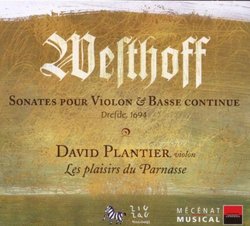| All Artists: Johann Paul von Westhoff, David Plantier, Les Plaisirs du Parnasse Title: Johann Paul von Westhoff: Sonatas for Violin & Basso Continuo, Dresden, 1694 - David Plantier / Les Plaisirs du Parnasse Members Wishing: 0 Total Copies: 0 Label: Zig Zag Territoires Original Release Date: 1/1/2005 Re-Release Date: 11/8/2005 Genre: Classical Styles: Chamber Music, Historical Periods, Baroque (c.1600-1750), Classical (c.1770-1830) Number of Discs: 1 SwapaCD Credits: 1 UPC: 3760009290754 |
Search - Johann Paul von Westhoff, David Plantier, Les Plaisirs du Parnasse :: Johann Paul von Westhoff: Sonatas for Violin & Basso Continuo, Dresden, 1694 - David Plantier / Les Plaisirs du Parnasse
CD Details |
CD ReviewsWorth knowing him HSIEH CHENG CHUNG | Taipei, Taiwan | 07/12/2007 (5 out of 5 stars) "Again, Zig Zag Territoires had released a good one to deliver excellent composer. Westhoff had big influence on Bach's violin technique, and early composition style, it's a collection style of Italy and South-Germany. The beautiful and soft tone would touch your deep emotion." Blazing Strings! M. De Sapio | Alexandria, VA | 12/15/2009 (5 out of 5 stars) "If you love the violin virtuosity of Schmelzer and Biber, then you are in for a treat. Johann Paul von Westhoff (1656-1705) is best known for having written a set of suites for unaccompanied violin which likely influenced Bach to write his famous Sonatas and Partitas; as this disc shows, Westhoff deserves to be recognized as a composer in his own right. These six sonatas for violin and continuo, published in Dresden in 1694, are given their premiere recording here by the French group Les Plaisirs du Parnasse led by violinist David Plantier.
Westhoff's sonatas stand midway between the mercurial solo pieces of the 17th century and the more formally structured Corellian type of sonata that would become the norm after 1700. The sonatas do have self-contained movements, but they tend to be compact and follow one upon the other in a spontaneous flow. All the sonatas have fast movements with skillfully contrived two-voice counterpoint in double stops for the violin; there are also passacaglias, sarabandes, and gigues (though not so named), as well as arias. Westhoff even engages in the 17th-century pursuit of descriptive music with a pizzicato movement in imitation of a lute and a piece imitating bells (the bariolage in the latter reminds one of Bach's violin Chaconne). Some of the movements are unconventional to the point of being bizarre - like the opening of Sonata no. 2, which skulks around in circles, never going anywhere. The bass line is often coequal in importance with the violin part, shadowing and dialoguing and weaving intricate counterpoints to it. All of the sonatas are in minor keys, and their published order has been scrambled for this recording in a way that makes for a convincing dramatic presentation. As it happens, Westhoff's sonatas work nicely as a complete set on disc; they combine drama, rhetoric and lyricism with intellectual rigor. David Plantier brings passion and panache to these pieces: he draws a vibrant, expressive, penetrating yet airy tone from his instrument, and his imaginative ornaments are a delight. Plantier is a fine young violinist, and I hope to hear more from him. He is supported by a continuo group of harpsichord, archlute, and cello which can caress, interject explosively, or envelop the violin line in a blaze of color. I could have wished for a more varied treatment of the contrapuntal fast movements, many of which are played quite fast and with overly busy continuo (surely it's not always necessary for the harpsichordist's left hand to double the bass line?) Otherwise, this disc is a fine achievement which should help put Westhoff's name "on the map". Heartily recommended to all baroque enthusiasts." |


 Track Listings (31) - Disc #1
Track Listings (31) - Disc #1